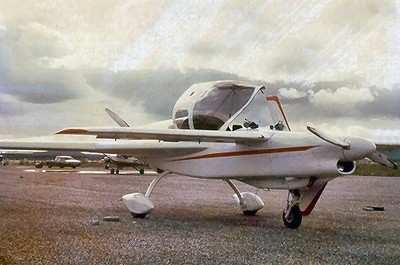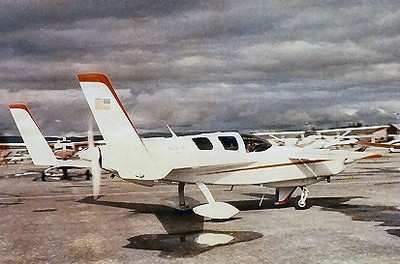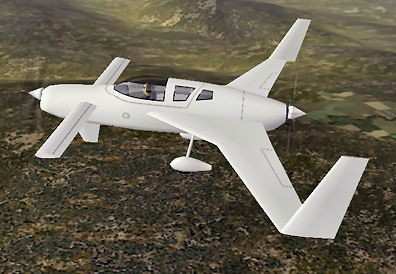The NTSB has filed the
factual report on a tragic, fatal crash of a Rutan Defiant (file
pictures and illustrations below), center-line twin-engine,
homebuilt SportPlane. The report confirms media eyewitness reports
thatt he aircraft experienced some control difficulties as a result
of the aircraft's canopy coming open in flight.
NTSB Factual Report
On December 17, 2004, about 1340 central standard time, an Akers
Douglas RA40 Defiant, inline twin-engine experimental airplane,
N765MM, was destroyed when it impacted the ground, following a loss
of control during takeoff initial climb from the Slaton Municipal
Airport (F49), near Slaton, Texas. The instrument rated private
pilot, sole occupant of the airplane, sustained fatal injuries. The
airplane was registered to and operated by the pilot. Visual
meteorological conditions prevailed and a flight plan was not filed
for the 14 Code of Federal Regulations Part 91 personal flight.
An investigator from the National Transportation Safety Board, a
representative from the Federal Aviation Administration, and local
law enforcement officials interviewed five eyewitnesses. Summaries
of their observations are cited below.
Witnesses #1 and #2
were standing at the edge of the taxiway east of the ramp when they
first observed the airplane at the south end of the runway about to
start its takeoff roll. As the airplane accelerated down runway 36,
witness #2 took several pictures of the departing airplane. The
witnesses reported that shortly after takeoff they observed the
canopy "pop open." The witnesses then heard a reduction in noise
from the engines and observed the airplane descend back towards the
runway. Seconds later, they heard the noise from the engines
increase as the airplane resumed climbing. Witness #1 further
reported that as the airplane was climbing, she could see the
canopy "bobbing" up and down, and approximately 700 feet above
ground level (agl), it appeared that the canopy departed the
airplane.
A review of the photos taken by witness #2 revealed that the
canopy was in an open position while the airplane was approximately
25 feet agl.
Witness #3 was standing at the self-service fuel pumps, abeam
runway 36 near the halfway point, when he observed the airplane
taxi to the south end of the runway for a north departure. The
witness reported that just after the airplane departed the runway,
the canopy opened to a near-vertical position. He then heard the
engine noise reduce for a brief moment, then increase, and shortly
thereafter saw the canopy go towards the closed position.
Witness #4 was standing on the ramp when he observed the
airplane "wallowing" in the air. The witness reported that when the
airplane was approximately 500-700 agl, he saw a flash of light
come from the airplane. Several minutes later, when he again
returned his attention to the airplane, it was in a nose down
attitude and disappeared from view into a canyon that is located
north of the airport.

Witness #5 was welding on a fence approximately one mile north
of the airport. The witness reported that he first noticed the
airplane shortly after it had taken off from the airport. As the
airplane passed overhead in a northerly direction, he observed
papers coming out of the cockpit. The witness then observed the
airplane initiate an approximate 315-degree descending left turn.
After rolling out on a northeast heading, the airplane started
banking back and forth and pitching up and down rapidly before
finally settling in a nose down attitude. The airplane remained in
this attitude until it contacted the ground. The witness further
reported that he did not see anything other than papers fall from
the airplane.
An inspector from the Federal Aviation Administration performed
an onsite examination of the wreckage. The inspector reported that
all major components of the airplane, including the canopy, were
accounted for at the wreckage site. The inspector further reported
that the airplane had been destroyed during a post impact fire.
The pilot held a FAA private pilot certificate with ratings for
single-engine land, multi-engine land, and instrument airplane. At
the time of his last third-class FAA medical certificate, issued on
December 15, 2004, the pilot reported his total flight time as
2,300 hours, with 60 hours in the preceding six months. The pilot's
personal logbooks were not available for review during the course
of the accident investigation.
The composite airplane was a four seat experimental RA40
Defiant, serial number 162. The airplane was powered by two Textron
Lycoming O-320 four-cylinder reciprocating engines. The propellers
were of composite construction. The canopy was a one-piece design
that covered all four seats. It was attached by a piano hinge along
the right side of the cabin, and pivoted to the right side when
open. The control stick was located on the left side of the
cockpit. The airplane's logbooks were not available for review
during the course of the investigation; therefore, the airframe and
engine time, and the date and type of the last inspection could not
be determined.

According to the Defiant owners manual, first edition, dated May
1988, the "canopy opening in flight is a serious emergency." The
manual further states the following: "With the canopy unlatch
warning and the safety catch, the likelihood of a canopy opening in
flight is remote. However, should the canopy open to the safety
latch, the aircraft is still controllable. Reduce airspeed to
minimize windblast and return and land. Should the canopy come
fully open in flight it will probably come off and take the rear
prop with it. You will be faced with air blast and a single engine
airplane with high drag. The performance or flying qualities of
this configuration have not been tested. Remember to maintain
aircraft control. Do not be so concerned with closing the canopy
that you allow the aircraft to fly unnecessarily into the ground. A
low speed of 70 to 75 knots is recommended for canopy-off failure
condition."
Fueling records obtained from a local fixed-base operator
revealed that the airplane was last fueled on December 17, 2004,
with 30.18 gallons of 100 Low Lead aviation fuel.
The Lubbock County Medical Examiner performed an autopsy on
December 18, 2004. The FAA Toxicology and Accident Research
Laboratory in Oklahoma City, Oklahoma, performed toxicological
testing of specimens of the pilot. The results of analysis were
negative for volatiles and tested drugs. The report contained the
following positive results: 20 percent carbon monoxide and 1.7
(ug/ml) cyanide detected in blood.

At 1353, the automated weather observing system at Lubbock
International Airport (LBB), near Lubbock, Texas, located
approximately 13.4 miles northwest of the accident site, reported
wind from 240 degrees at 12 knots, visibility 10 statute miles, sky
clear, temperature 54 degrees Fahrenheit, dew point 23 degrees
Fahrenheit, and a barometric pressure setting of 30.29 inches of
Mercury.
 ANN's Daily Aero-Linx (04.13.24)
ANN's Daily Aero-Linx (04.13.24) ANN's Daily Aero-Term (04.13.24): Beyond Visual Line Of Sight (BVLOS)
ANN's Daily Aero-Term (04.13.24): Beyond Visual Line Of Sight (BVLOS) Airborne 04.09.24: SnF24!, Piper-DeltaHawk!, Fisher Update, Junkers
Airborne 04.09.24: SnF24!, Piper-DeltaHawk!, Fisher Update, Junkers Aero-News: Quote of the Day (04.14.24)
Aero-News: Quote of the Day (04.14.24) ANN's Daily Aero-Term (04.14.24): Maximum Authorized Altitude
ANN's Daily Aero-Term (04.14.24): Maximum Authorized Altitude





